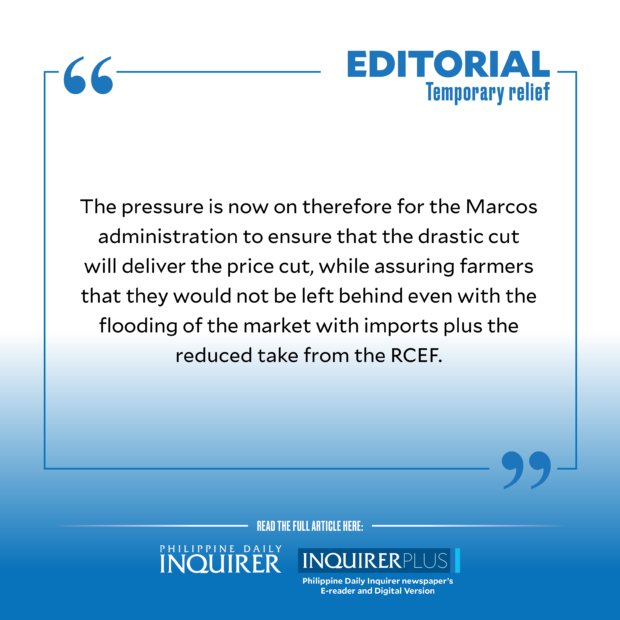Temporary relief

Rice prices are tipped to drop by as much as P9 a kilo in July after President Marcos ordered last week a drastic cut in the tariffs on imported rice from 35 percent to 15 percent to give Filipinos much-needed relief from soaring prices of basic commodities.
A group of rice traders that had met Speaker Ferdinand Martin Romualdez predict the following prices by July and August—P45 to P46 a kilo for well-milled rice consumed by ordinary Filipinos and P47 to P48 a kilo for premium rice consumed by the middle class.
While still more than double the P20 a kilo that President Marcos had promised Filipinos during his presidential campaign in 2022, any price cut as a result of Executive Order No. 62 is nevertheless a welcome relief for consumers and households whose purchasing power had been weakened by high inflation.
That is, however, if the anticipated reduction will actually come to pass.Expectations have to be tempered by the cold fact that world market prices of the country’s staple and one of the world’s most traded and consumed commodities are still increasing. This is due to tight supply given elevated demand as well as the global impact of the El Niño weather phenomenon that cut production.
World’s biggest importer
Secretary Arsenio Balisacan of the National Economic and Development Authority accurately described the international rice market as “thin,” which means that any adverse developments in global producers such as Vietnam will cause “disruptions in the world market,” ergo higher prices.
This shines a light on concerns raised by critics that the tariffs will actually not do much to bring down consumer prices while causing extensive damage to the local rice farmers who may be dissuaded from planting rice thus further constricting supply and making the Philippines depend even more on imports.
As it is, the Philippines is already the world’s biggest importer and stands to import even more.
According to the estimates by the United States Department of Agriculture, the Philippines may import 4.6 million metric tons of rice this year with the lower tariffs, up by 500,000 MT from the earlier target of 4.1 million MT, and going up further to 4.7 million MT next year.
If the forecast materializes, then the Philippines will keep its title as the world’s top importer for three years until 2025, with the imported volume now accounting for some 20 percent of the country’s annual needs.
Flooded with imported rice
Agriculture groups are indeed not happy with EO 62 and have said they would file a petition to put a stop to the implementation of the EO that revised the duty rates for key products, including rice and coal, until 2028.
Samahang Industriya ng Agrikultura president Rosendo So expressed fears that around 500,000 farmers will be displaced by the EO, claiming that it will negatively impact local producers and only benefit the rice importers. So added that based on experience, importation has not significantly brought down the prices of local products.
And as if that were not enough, the lower tariff will mean reduced collections going into the Rice Competitiveness Enhancement Fund (RCEF), which is being used to finance projects to help raise the income and productivity of local farmers. Last year, some P29 billion went into the RCEF.
Former agriculture secretaries are just as skeptical that the reduced tariffs will deliver as expected.
For Leonardo Montemayor, the lower tariffs are “a very clear signal [to the world market] to export [more rice to the Philippines],” thus “good luck with the government’s promise that we will not be flooded with imported rice.”
Emmanuel Piñol agreed, saying that rice prices would remain the same despite the tariff reduction.
Temporary measures
“Reducing tariff would encourage importers to bring in more rice, which would be sold at the same price, but which would dampen the planting intentions of Filipino rice farmers,” Piñol said in an open letter addressed to Balisacan.
The Marcos administration is not blind to these concerns, but at this point firmly believes that reducing tariffs is the best solution to immediately bring down prices.
The pressure is now on therefore for the Marcos administration to ensure that the drastic cut will deliver the price cut, while assuring farmers that they would not be left behind even with the flooding of the market with imports plus the reduced take from the RCEF.
And while doing that, it would do well for the Marcos administration to look at these tariff cuts as temporary measures, and that the final objective is to shore up local production to help farmers and at the same time wean the country away from imports that expose the country to volatility in the peso-dollar exchange rate and the whims of the global market.
By helping farmers, we will help ourselves, too, as it will fix the longstanding problem with supply for the long term, instead of relying on another quick fix that may end up being just another broken vow.




















